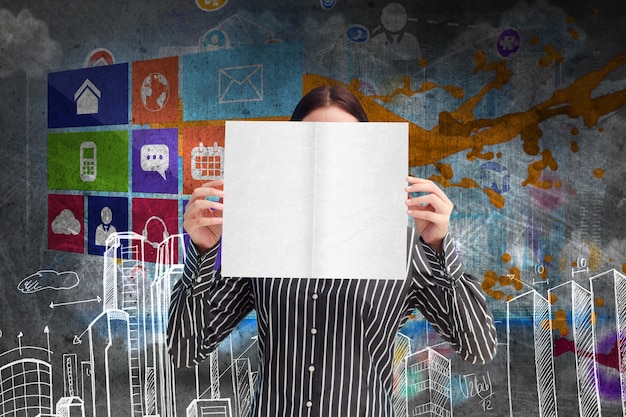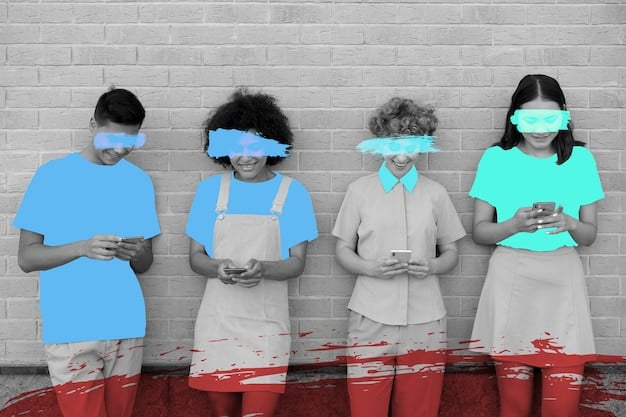Memes in 2025: Decoding Internet Culture and Its Significance

The Cultural Significance of Memes: Decoding the Language of the Internet in 2025 reveals how memes have evolved into a vital form of communication, cultural expression, and social commentary, deeply influencing online interactions and shaping contemporary culture.
Have you ever wondered how a simple image with text can encapsulate complex emotions, ideas, and cultural trends? The story of the cultural significance of memes: decoding the language of the internet in 2025 is about understanding how they’ve become a primary form of online communication.
The Evolving Landscape of Memes
In an increasingly digital world, memes have transcended their initial role as mere internet jokes. They have become a powerful force shaping cultural trends, political discourse, and even marketing strategies. But what exactly is the cultural significance of memes in 2025, and how are they changing the way we communicate online?
To understand this phenomenon, it’s essential to recognize that memes are more than just humorous images or videos. They are a form of shorthand, a shared language that allows people to connect with one another through humor, irony, and social commentary. As technology advances and the internet continues to evolve, so too do the memes that populate our digital landscape.
Memes as Cultural Currency
Memes have become a form of cultural currency, with their popularity and virality often reflecting broader societal trends and concerns. They provide a unique lens through which to view the world, offering a humorous and often satirical take on current events, social issues, and human behavior.
The Democratization of Content Creation
One of the most significant aspects of meme culture is its democratizing effect on content creation. Unlike traditional media, which often requires specialized skills and resources, memes can be created and shared by anyone with an internet connection. This has led to a more diverse and inclusive online landscape, where individuals from all backgrounds can contribute to the cultural conversation.
- Accessibility: The ease of creating and sharing memes allows for broader participation.
- Relevance: Memes often reflect current events, making them a timely form of social commentary.
- Impact: Viral memes can significantly influence public opinion and cultural trends.
As we move further into the 21st century, it’s clear that memes will continue to play a significant role in shaping our culture. Their ability to capture complex ideas in a concise and humorous format makes them a powerful tool for communication and social expression. Understanding the cultural significance of memes is, therefore, essential for anyone seeking to navigate the ever-evolving digital landscape.
In conclusion, memes have evolved from simple jokes to potent forms of cultural expression, their dynamic nature ensures their continued relevance in shaping online communication.
The Language of the Internet: Decoding Meme Communication
Memes have evolved into the native language of the internet. They are how ideas, emotions, and cultural references are transmitted in the digital realm. But how does this language work, and what makes it so effective?
Decoding meme communication involves understanding the underlying cultural context, recognizing the different types of memes, and appreciating the nuances of humor and irony that they often employ. It’s about being able to decipher the message being conveyed and recognizing the shared cultural references that make it resonate with others.

Meme Syntax and Grammar
Like any language, memes have their own syntax and grammar. Certain formats and templates are commonly used to convey particular types of messages, and understanding these conventions is essential for effective communication. For example, the “Drake approves/disapproves” meme format is often used to express preferences or contrasts, while the “Distracted Boyfriend” meme is used to satirize infidelity or divided loyalties.
The Role of Humor and Irony
Humor and irony are central to meme communication. Memes often use humor to make serious points or to satirize social norms and cultural trends. Irony, sarcasm, and self-deprecation are also common features of meme culture, adding layers of meaning and complexity to the messages being conveyed.
- Context: Understanding the cultural and social context is crucial for interpreting memes correctly.
- Format: Recognizing common meme formats and templates helps to decipher their meaning.
- Humor: Appreciating the humor and irony in memes allows for a deeper understanding of their message.
As the language of the internet continues to evolve, so too will the memes that populate our digital landscape. To stay fluent in this ever-changing language, it’s essential to remain open to new forms of expression and to constantly update our understanding of cultural trends and social norms. By decoding meme communication, we can gain valuable insights into the way people think, feel, and interact in the digital age.
In essence, meme communication is a unique form of digital language that communicates volumes in a quick, humorous, and relatable manner, highlighting the importance of context and cultural literacy in the internet age.
Memes as Social Commentary: Reflecting and Shaping Society
Memes often serve as a mirror reflecting societal values, beliefs, and anxieties. They provide a platform for individuals to express their opinions, share their experiences, and engage in social commentary. But how exactly do memes reflect and shape society, and what makes them such a powerful tool for social change?
The key lies in their ability to capture complex ideas and emotions in a concise and relatable format. Memes can distill complex social issues into easily digestible messages, making them accessible to a wider audience. They can also use humor and satire to challenge established norms and provoke critical thinking about important social issues.
Political Memes and Activism
Political memes have become an increasingly important tool for activism and political discourse. They can be used to raise awareness about important issues, mobilize support for political candidates, and challenge the status quo. By using humor and satire, political memes can cut through partisan divides and engage people in a way that traditional political messaging often fails to do.
Memes and Social Movements
Memes have also played a significant role in social movements, providing a platform for marginalized voices to be heard and for communities to connect with one another. They can be used to share personal stories, raise awareness about social injustices, and build solidarity among activists.
- Awareness: Memes can raise awareness about important social issues and political events.
- Mobilization: They can mobilize support for social movements and political causes.
- Solidarity: Memes can build solidarity among activists and marginalized communities.
The power of memes as social commentary lies in their ability to connect with people on an emotional level and to challenge established norms and power structures. While they may not always be taken seriously, their influence on public opinion and cultural trends is undeniable. As we move further into the digital age, it’s likely that memes will continue to play a significant role in shaping society and driving social change.
In conclusion, memes as social commentary reflect and influence society by humorously condensing complicated topics, making them accessible and sparking dialogue, thereby impacting cultural views.
The Dark Side of Memes: Misinformation and Manipulation
While memes can be a powerful tool for communication and social change, they also have a dark side. The ease with which they can be created and shared makes them susceptible to misinformation, manipulation, and the spread of harmful content. What are the potential downsides of meme culture, and how can we protect ourselves from their negative effects?
One of the biggest concerns is the spread of misinformation. False or misleading memes can quickly go viral, spreading harmful narratives and influencing public opinion. This can have serious consequences, particularly in the context of political discourse and public health.

The Echo Chamber Effect
Memes can also contribute to the echo chamber effect, reinforcing existing biases and limiting exposure to diverse perspectives. When people are primarily exposed to memes that align with their own beliefs, they become less likely to engage with opposing viewpoints, leading to increased polarization and social division.
Cyberbullying and Online Harassment
Another concern is the use of memes for cyberbullying and online harassment. Memes can be used to target individuals or groups with hateful or offensive content, causing emotional distress and potentially leading to real-world harm.
- Misinformation: Memes can spread false or misleading information, influencing public opinion.
- Polarization: They can contribute to the echo chamber effect, reinforcing existing biases and social divisions.
- Harassment: Memes can be used for cyberbullying and online harassment, causing emotional distress.
To protect ourselves from the negative effects of meme culture, it’s important to be critical of the content we consume and share. We should always verify the information presented in memes and be mindful of the potential for bias and manipulation. It’s also important to be respectful of others online and to avoid sharing memes that are hateful or offensive.
In summary, the negative potential of memes includes the spread of misinformation and the echo chamber effect, highlighting the need for media literacy and mindfulness.
Memes in Marketing: Engaging Consumers in 2025
Recognizing the broad cultural influence of memes, marketers are finding them an effective approach to engage consumers. In 2025, memes are a vital component of any marketing strategy, helping brands connect with their target audiences in a fun, engaging, and relatable way. But how exactly can memes be used effectively in marketing, and what are the key considerations for brands?
One of the most important things to keep in mind is authenticity. Consumers can quickly spot inauthentic or forced attempts to use memes for marketing purposes, and these efforts can often backfire. To be successful, brands need to demonstrate a genuine understanding of meme culture and to use memes in a way that feels natural and organic.
Creating Relatable Content
Memes can be used to create relatable content that resonates with consumers on an emotional level. By tapping into shared experiences, cultural references, and common frustrations, brands can use memes to build a sense of connection with their target audiences.
Boosting Brand Awareness
Memes can also be used to boost brand awareness and drive engagement. Viral memes can reach a wide audience, exposing new consumers to the brand and its products or services. By incorporating branding elements into memes, brands can increase brand recognition and create lasting impressions.
- Authenticity: Brands need to demonstrate a genuine understanding of meme culture.
- Relatability: Memes can be used to create relatable content that resonates with consumers.
- Engagement: They can boost brand awareness and drive engagement with target audiences.
As meme culture continues to evolve, marketers need to stay up-to-date on the latest trends and formats. They also need to be mindful of the potential for backlash and to avoid using memes in a way that is offensive or insensitive. By using memes thoughtfully and strategically, brands can tap into the power of internet culture to connect with consumers and drive business results.
Ultimately, memes in marketing in 2025 offer engaging, relatable, and authentic opportunities but also require cultural awareness and a nuanced strategy to succeed.
The Future of Memes: Trends and Predictions
As technology continues to advance and the internet becomes even more deeply integrated into our lives, the future of memes is likely to be shaped by several key trends. What can we expect to see in the years to come, and how will memes continue to evolve as a form of communication and cultural expression?
One of the most significant trends is the increasing use of artificial intelligence (AI) in meme creation and distribution. AI-powered tools can automatically generate memes based on user input or current events, making it easier than ever for people to create and share content. This could lead to an explosion of new memes and formats, further democratizing content creation and expanding the reach of meme culture.
Interactive and Personalized Memes
Another trend is the rise of interactive and personalized memes. As technology advances, memes are becoming more dynamic and engaging, incorporating elements of interactivity and personalization. This could involve creating memes that respond to user input, adapting to individual preferences, or incorporating personalized data.
Memes in Virtual and Augmented Reality
We can also expect to see memes increasingly integrated into virtual and augmented reality experiences. As these technologies become more mainstream, memes could be used to enhance immersion, create shared experiences, and add layers of humor and social commentary to virtual and augmented environments.
- AI: AI-powered tools will make it easier to create and share memes.
- Interactivity: Memes will become more dynamic and engaging, incorporating elements of interactivity.
- VR/AR: Memes will be integrated into virtual and augmented reality experiences.
The future of memes is likely to be characterized by increased personalization, interactivity, and integration with emerging technologies. As memes continue to evolve, they will remain a powerful tool for communication, social commentary, and cultural expression, shaping the way we connect with one another in the digital age.
The forecast for the future of memes includes sophisticated technology-driven trends, greater personalization, and deeper integration into extended realities, impacting digital culture forever.
| Key Aspect | Brief Description |
|---|---|
| 😂 Cultural Shorthand | Memes act as a digital shorthand, quickly communicating complex ideas through humor. |
| 📢 Social Commentary | Memes serve as a platform for reflecting and commenting on societal issues and trends. |
| 🌐 Marketing Tool | Brands leverage memes to authentically connect with consumers and enhance marketing strategies. |
| 🔮 Future Trends | AI, interactivity, and VR integration will shape the future evolution and impact of memes. |
Frequently Asked Questions
▼
Memes are a reflection of current trends and dialogues, becoming a primary way people communicate culture and participate in shared online experiences. Their rapid spread allows concepts to disseminate widely.
▼
Memes utilize recognizable elements—images, phrases—to convey complex thoughts or emotions quickly. They require a shared understanding to fully decode, evolving the internet’s linguistic landscape.
▼
Yes, because they simplify complicated concepts and can provoke emotional reactions. By framing issues in accessible ways, they can sway opinions and generate support for movements.
▼
Risks include disinformation due to their high distribution rate, echo chamber effects reinforcing skewed perspectives, and potential misuse in online harassment campaigns causing digital and emotional harm.
▼
Marketers may leverage personalized trending memes to resonate better with digital audiences and ensure campaigns reflect an ethical, culturally mindful approach as well as be authentic to their brands
Conclusion
In conclusion, the cultural significance of memes: decoding the language of the internet in 2025 showcases how memes have transformed online communication, evolving into a cultural force that reflects and shapes societal trends, requiring digital literacy and critical awareness to navigate their complex influence.





